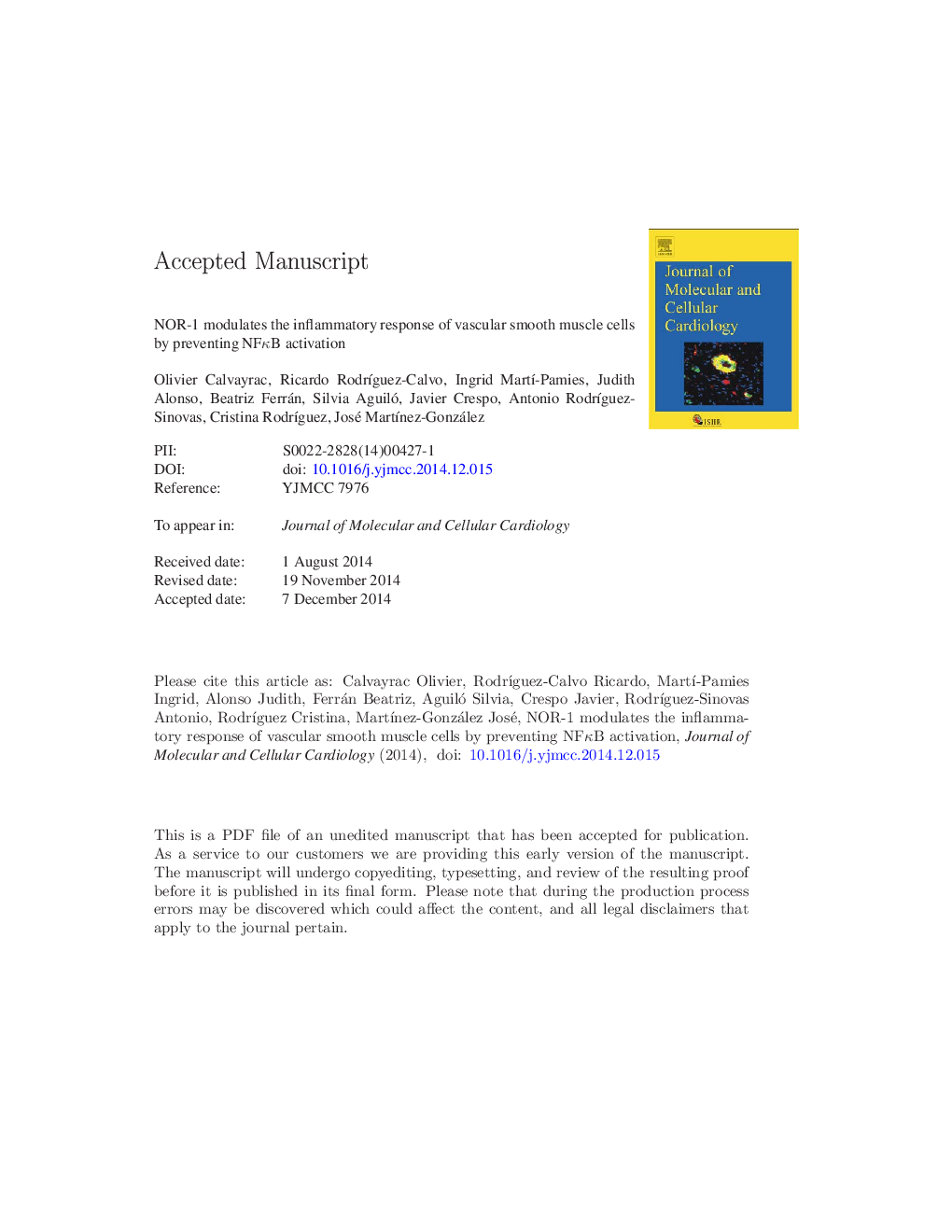| کد مقاله | کد نشریه | سال انتشار | مقاله انگلیسی | نسخه تمام متن |
|---|---|---|---|---|
| 8474377 | 1550425 | 2015 | 36 صفحه PDF | دانلود رایگان |
عنوان انگلیسی مقاله ISI
NOR-1 modulates the inflammatory response of vascular smooth muscle cells by preventing NFκB activation
دانلود مقاله + سفارش ترجمه
دانلود مقاله ISI انگلیسی
رایگان برای ایرانیان
کلمات کلیدی
eGFPnLDLMDANr4aoxLDLFCSTBARSDMEMOxidized LDL - LDL اکسید شدهMOI - MEDulbecco's modified Eagle's medium - Medal of Eagle اصلاح شده DulbeccoSmall interfering RNA - RNA تداخل کوچکsiRNA - siRNAElectrophoretic mobility shift assay - آزمون تحرک تحرک الکتروفورزfoetal calf serum - سرم گوساله جنینEndothelial cells - سلولهای اندوتلیالEMSA یا electrophoretic mobility shift assay - سنجش تغییر تحرک الکتروفورتیکmalondialdehyde - مالون دی آلدهیدthiobarbituric acid-reactive substances - مواد واکنش پذیر اسید تیوباربیتوریکenhanced green fluorescent protein - پروتئین فلورسنت سبز افزایش یافته استmultiplicity of infection - چندین عفونت
موضوعات مرتبط
علوم زیستی و بیوفناوری
بیوشیمی، ژنتیک و زیست شناسی مولکولی
بیولوژی سلول
پیش نمایش صفحه اول مقاله

چکیده انگلیسی
Recent work has highlighted the role of NR4A receptors in atherosclerosis and inflammation. In vascular smooth muscle cell (VSMC) proliferation, however, NOR-1 (neuron-derived orphan receptor-1) exerts antagonistic effects to Nur77 and Nurr1. The aim of this study was to analyse the effect of NOR-1 in VSMC inflammatory response. We assessed the consequence of a gain-of-function of this receptor on the response of VSMC to inflammatory stimuli. In human VSMC, lentiviral over-expression of NOR-1 reduced lipopolysaccharide (LPS)-induced up-regulation of cytokines (IL-1β, IL-6 and IL-8) and chemokines (MCP-1 and CCL20). Similar effects were obtained in cells stimulated with TNFα or oxLDL. Conversely, siRNA-mediated NOR-1 inhibition significantly increased the expression of pro-inflammatory mediators. Interestingly, in the aortas from transgenic mice that over-express human NOR-1 in VSMC (TgNOR-1), the up-regulation of cytokine/chemokine by LPS was lower compared to wild-type littermates. Similar results were obtained in VSMC from transgenic animals. NOR-1 reduced the transcriptional activity of NFκB sensitive promoters (in transient transfections), and the binding of NFκB to its responsive element (in electrophoretic mobility shift assays). Furthermore, NOR-1 prevented the activation of NFκB pathway by decreasing IκBα phosphorylation/degradation and inhibiting the phosphorylation and subsequent translocation of p65 to the nucleus (assessed by Western blot and immunocytochemistry). These effects were associated with an attenuated phosphorylation of ERK1/2, p38 MAPK and Jun N-terminal kinase, pathways involved in the activation of NFκB. In mouse challenged with LPS, the activation of the NFκB signalling was also attenuated in the aorta from TgNOR-1. Our data support a role for NOR-1 as a negative modulator of the acute response elicited by pro-inflammatory stimuli in the vasculature.
ناشر
Database: Elsevier - ScienceDirect (ساینس دایرکت)
Journal: Journal of Molecular and Cellular Cardiology - Volume 80, March 2015, Pages 34-44
Journal: Journal of Molecular and Cellular Cardiology - Volume 80, March 2015, Pages 34-44
نویسندگان
Olivier Calvayrac, Ricardo RodrÃguez-Calvo, Ingrid MartÃ-Pamies, Judith Alonso, Beatriz Ferrán, Silvia Aguiló, Javier Crespo, Antonio RodrÃguez-Sinovas, Cristina RodrÃguez, José MartÃnez-González,